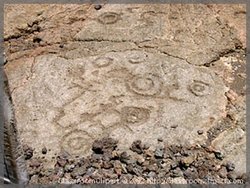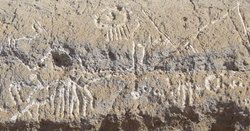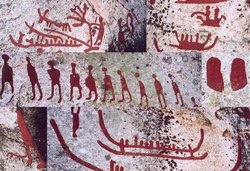Petroglyph
|
|


A Petroglyph is an image recorded on stone, usually by prehistoric peoples, by means of carving, pecking or otherwise incised on natural rock surfaces. They are commonly associated with Neolithic people, and were a dominant form or pre-writing symbols used in communication from approximately 10,000 B.C. to 5,000 B.C. The word comes from the Greek words petros meaning "stone" and glyphein meaning "to carve" (it was originally coined in French as p鴲oglyphe). These images may have had deep cultural and religious significance for the societies that created them.
The term 'petroglyph' should not be confused with either the term "pictograph" - a more advanced symbol type, which uses the images to tells the chronological story spanning through time - nor with cave painting. The difference between cave painting and petroglyphs is twofold: first, petroglyphs are carved or engraved, while cave paintings refer to the images painted on stone. Second, petroglyphs are more evolved symbols compared to the cave paintings, showing specific events more clearly.
| Contents |
History
Petroglyphs are commonly associated with Neolithic people, and were a dominant form of pre-writing symbols used in communication from approximately 10,000 B.C. to 5,000 B.C. when they begun to be replaced by more advanced writing systems using pictographs and ideograms. The oldest petroglyphs are dated to the border times between the neolithic and late Upper Paleolithic eras. More primitive societies have been using petroglyphs much longer, some even until they made contact with Western culture in the 20th century. Petroglyphs have been found on all continents except Antarctica with highest concentration in Africa, Scandinavia, Siberia, North America and Australia.
Meaning
These images had deep cultural and religious significance for the societies that created them; in many cases, this significance remains for their descendants. Many petroglyphs are thought to represent some kind of not yet fully understood symbolic or ritual language. The later carvings from the Nordic Bronze Age in Scandinavia seem to indicate some form of territory boundaries between tribes, except its religious meaning. There appear to be "dialects" between neighborhood and contemporary petroglyphs. The Siberian inscriptions almost looks like some early form or runes, although there is no relationship. They are not yet understood.
The West Virginia glyphs are worth noting for the controversy that erupted over them in the 1980s. Barry Fell, a retired professor of marine biology at Harvard, published an article in 1983, describing how he had deciphered petroglyphs in several places in southern West Virginia to actually be written in Ogam, an Irish Celtic script dating back to the 6th to 8th century AD, and that they were, in fact, a detailed description of the nativity of Christ. Fell is noted as promoting a theory of North America being visited by Irish, Iberian, Libyan, and Egyptian explorers "some 2,000 to 2,500 years ago".
In fact, Fell's method of interpretation involved almost arbitrary grouping of markings, and interpreting them to be only the consonants of Ogam, then adding in vowels where he saw fit, in addition to adding horizontal stem lines where he saw fit, which allowed him to decide which of three consonants each glyph should represent. Fell's work was subsequently debunked by linguists and archaeologists from several countries, to which Fell responded by accusing them of being "too damn lazy" to read his writings, and of being "ignorant".
List of petroglyphs sites
Examples of petroglyphs can be found at:
Asia
- Bhimbetka, India
- Eight sites in Hong Kong: on Tung Lung Island, Kau Sai Chau, Po Toi Island, Cheung Chau, Shek Pik on Lantau Island, Wong Chuk Hang and Big Wave Bay on Hong Kong Island, Lung Ha Wan in Sai Kung
South America
North America
- Death Valley National Park
- Horsethief Lake State Park
- Kejimkujik National Park
- Newspaper Rock State Historic Monument
- Petit Jean State Park, Arkansas
- Petrified Forest National Park
- Petroglyph National Monument
- Petroglyph Provincial Park, Nanaim0, BC, Canada [1] (http://www.britishcolumbia.com/ParksAndTrails/Parks/details/?ID=450)
- Three Rivers Petroglyphs in New Mexico [2] (http://www.desertusa.com/mag98/mar/poi/du_3rivers.html)
- West Virginia glyphs
- Sloan Canyon National Conservation Area, Nevada
- http://www.rockartplanet.com
- http://www.idahorockart.com



